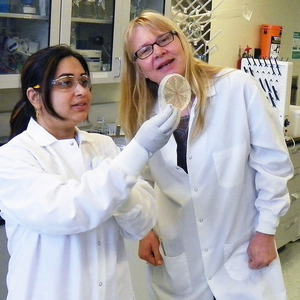Researchers produce jet fuel compounds from fungus

Photo: Washington State University
May 14, 2015
BY Washington State University
Washington State University researchers have found a way to make jet fuel from a common black fungus found in decaying leaves, soil and rotting fruit. The researchers hope the process leads to economically viable production of aviation biofuels in the next five years.
The researchers used Aspergillus carbonarius ITEM 5010 to create hydrocarbons, the chief component of petroleum, similar to those in aviation fuels.
Led by Birgitte Ahring, director and Battelle distinguished professor of the Bioproducts, Sciences and Engineering Laboratory at WSU Tri-cities, the researchers published their work in the April edition of Fungal Biology.
The fungus produced the most hydrocarbons on a diet of oatmeal but also created them by eating wheat straw or the nonedible leftovers from corn production.
Advertisement
Advertisement
Fungi have been of interest for about a decade within biofuels production as the key producer of enzymes necessary for converting biomass to sugars. Some researchers further showed that fungi could create hydrocarbons, but the research was limited to a specific fungus living within a specific tree in the rainforest, and the actual hydrocarbon concentrations were not reported.
Ahring’s group has previously been successful in using standard Aspergillus fungi to produce enzymes and other useful products, which have been patented and are under commercialization, so they decided to look into A. carbonarius ITEM 5010’s potential for biofuels.
Fungi are complex microorganisms and are not always easy to work with, Ahring said. They have a complex biology that is often poorly understood.
“Not many people in this world actually do this,’’ she said. “The molecular biology piece of it is complicated.’’
The researchers were assisted by Kenneth Bruno, a researcher at the U.S. DOE’s Pacific Northwest National Laboratory, who developed a method essential for the genetic manipulation of A. carbonarius. The research received funding from the Danish Council for Strategic Research under the program for Energy and Environment.
Advertisement
Advertisement
Using fungi for hydrocarbon and biofuels production is better than other methods because they do the work themselves, bypassing multiple complicated chemical processes required by other biofuel production methods. Fungi also have great potential to create the fuel at low cost, Ahring said.
She suspects the fungi produce hydrocarbons, large compounds that are costly for the organism to produce, as a protective mechanism. Her group showed that fungi react to bacterial attacks by increasing their hydrocarbon production.
The researchers are now working to optimize the fungi’s hydrocarbon production and improve biochemical pathways through genetic engineering. They have obtained mutants with a higher production level and are working on improving these strains by using gene coding for specific hydrocarbons out of blue green bacteria and algae.
It’s the same challenge faced by mold researchers, more than a generation ago, who found they could only produce a tiny amount of their product, Ahring said. Eventually, they optimized production of their product, which became known as antibiotics.
“It’s very promising,’’ she said. “I think that the fungus-based fuels are something that is going to happen. It’s a tremendous opportunity.”
Related Stories
Kintetsu World Express Inc. has entered into a new agreement with Shell Aviation regarding the use of SAF. Under this agreement, KWE will adopt Shell Aviation's digital platform "Avelia" to swiftly address shippers' low-carbon transportation needs.
The USDA maintained its outlook for 2025-’26 soybean oil use in biofuel production in its latest World Agricultural Supply and Demand Estimates report, released Aug. 12. The forecast for soybean oil prices was also unchanged.
U.S. soybean production for 2025 is forecast at 4.29 billion bushels, down 2% when compared to last year, according to the USDA National Agricultural Statistics Service’s latest monthly Crop Production report, released Aug. 12.
California’s new specified source feedstock attestation requirement: A critical new compliance step for renewable fuel producers
As of July 2025, California’s SCFS requires renewable fuel producers using specified source feedstocks to secure attestation letters reaching back to the point of origin. This marks a significant shift in compliance expectations.
At the University of Missouri, plant biochemist Jay Thelen is using arabidopsis as a powerful model to explore ways to boost oil production — an important step toward creating more sustainable, plant-based energy sources.
Upcoming Events










